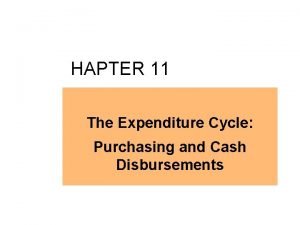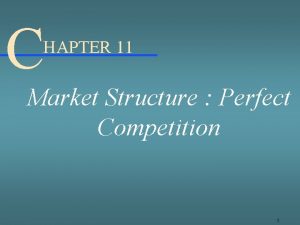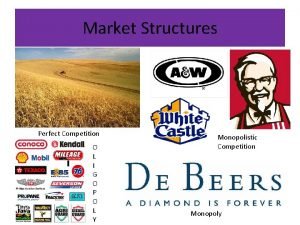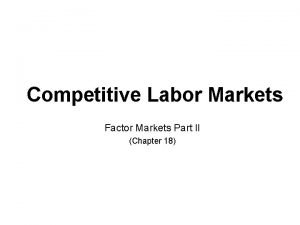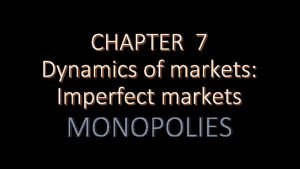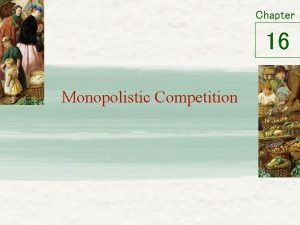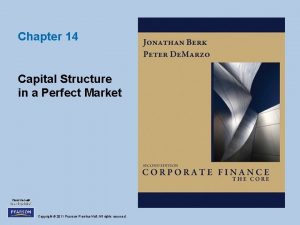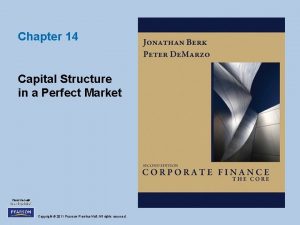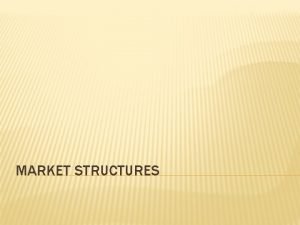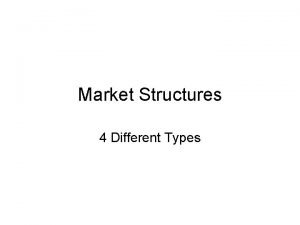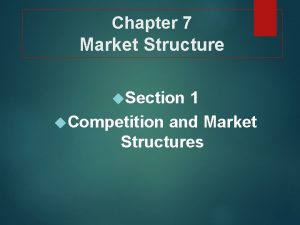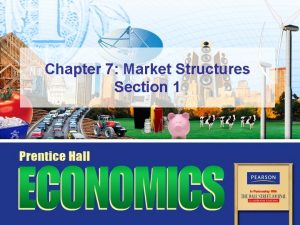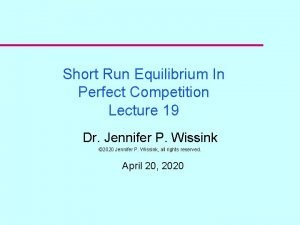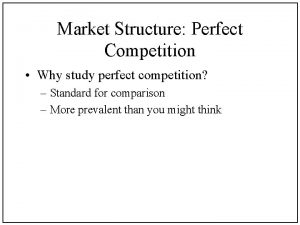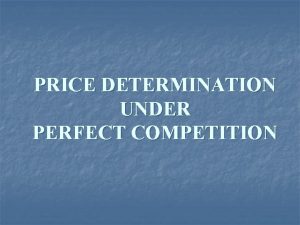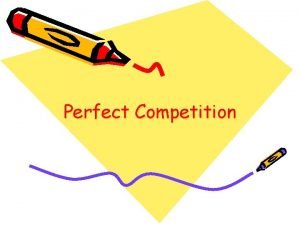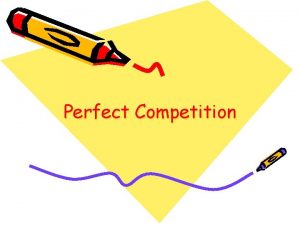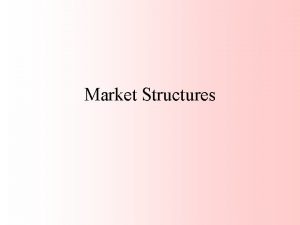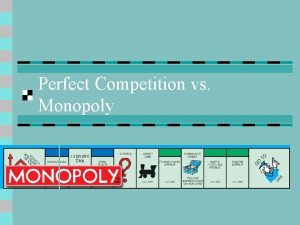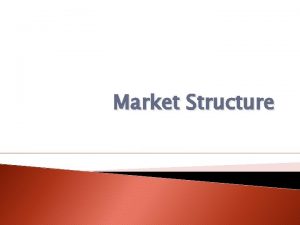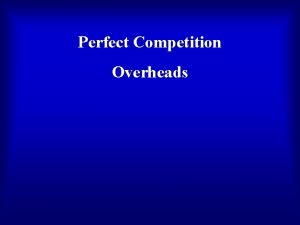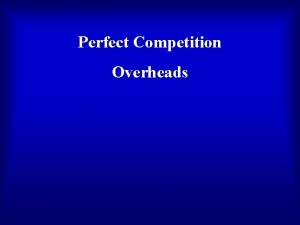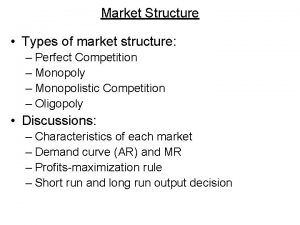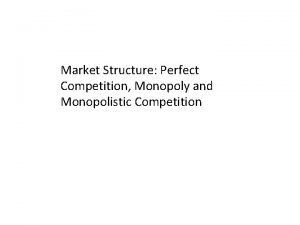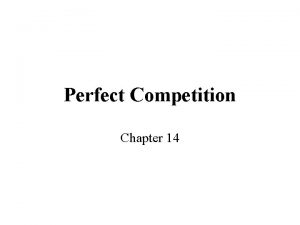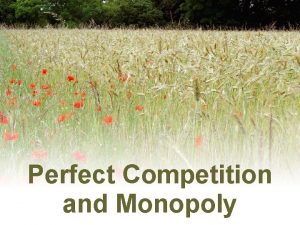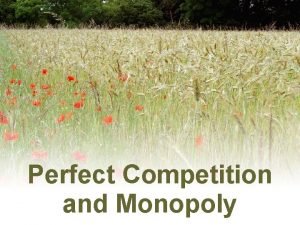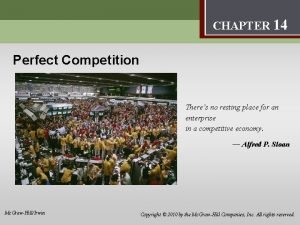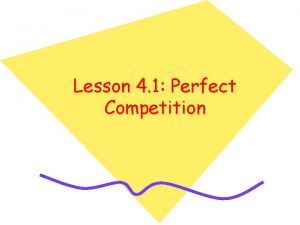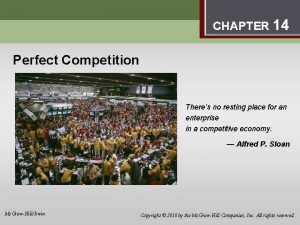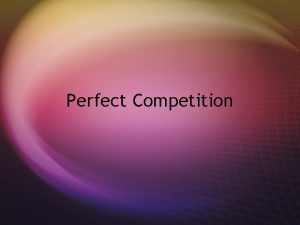C HAPTER 11 Market Structure Perfect Competition 1























- Slides: 23

C HAPTER 11 Market Structure : Perfect Competition 1

Market Structure l Type of market structure influences how a firm behaves: Pricing l Supply l Barriers to Entry l Efficiency l Competition l

Market Structure l Determinants of market structure Barriers of entry and exit l Nature of the product – homogenous (identical), differentiated? l Nature & Size Distribution of Sellers l Nature & Size Distribution of Buyers l Information flow l

Market Structure l Perfect l l l Competition: Free entry and exit to industry Homogenous product – identical so no consumer preference Large number of buyers and sellers – no individual seller can influence price Sellers are price takers – have to accept the market price Perfect information available to buyers and sellers

Market Structure l Examples of perfect competition: l Financial markets – stock exchange, currency markets, bond markets? l Agriculture? l To what extent?

Market Structure l Advantages l l l of Perfect Competition: High degree of competition helps allocate resources to most efficient use Price = marginal costs Normal profit made in the long run Firms operate at maximum efficiency Consumers benefit

Market Structure l What happens in a competitive environment? l l l New idea? – firm makes short term abnormal profit Other firms enter the industry to take advantage of abnormal profit Supply increases – price falls Long run – normal profit made Choice for consumer Price sufficient for normal profit to be made but no more!

Review: Short-Run Cost Curves Cost ($ per unit) MC AC AVC Cost ($ per unit) Output AFC = AC – AVC AFC Output 8

Short-Run Profit Maximization Under perfect competition, firms are “price takers. ” They can sell all they choose, at the market price.

Box 2. Total Revenue, Total Cost, and Profit 10

Box 3. Output, Total Revenue, and Marginal Revenue for a Competitive Firm 11

Box 4. Marginal Cost Calculated from Total Cost for a Competitive Firm 12

Box 5. Marginal Analysis for Profit Maximization 13

Box 6. Profit Maximization by a Competitive Firm 14

Box 7. A Competitive Firm in Equilibrium Earning Zero Profit 15

Box 8. A Competitive Firm Incurring Losses 16

Box 9. The Shutdown Point The firm’s shutdown price is the price at which the firm is indifferent between operating and shutting down. 17

The Long Run l The short run is a timeframe in which at least one of the resources used in production cannot be changed. l Exit l In and entry are long-run phenomena. the long run, all quantities of resources can be changed.

Adjustments in the Long Run l If economic profits are present new firms will come into the industry l The Market price will fall l The profit shrinks l Input prices may go up l Firms try to stay profitable by taking advantage of economies of scale l Firms adopt an optimal size l Economic profits tend toward zero

Figure: From Short-Run Profit To Long -Run Equilibrium Market Firm S 1 Price per Bushel A $4. 50 Dollars With initial supply curve S 1, market price is $4. 50… $4. 50 So each firm earns an economic profit. MC A d ATC 1 D 900, 000 Bushels per Year 9, 000 Bushels per Year

Figure: From Short-Run Profit To Long -Run Equilibrium Market Firm S 1 Price per Bushel S 2 Dollars MC A $4. 50 A d ATC 1 $4. 50 E 2. 50 E d 1 D 900, 000 1, 200, 000 Bushels per Year Profit attracts entry, shifting the supply curve rightward… 5, 000 9, 000 until market price falls to $2. 50 and each firm earns zero economic profit. Bushels per Year

Long-Run Competitive Equilibrium Graph P At long-run equilibrium, economic profits are zero MC LRATC SRATC P = D = MR Q 14 -22

Long-Run Equilibrium l. P = MC results from the assumption that firm’s are profit maximizers. l P = AC results because market forces cause long run economic profits to equal zero. l In the long run, firm owners will only earn normal returns on their investments.
 Hapter 11
Hapter 11 Hapter 11
Hapter 11 Lump sum subsidy monopoly
Lump sum subsidy monopoly Perfect competition vs monopolistic competition
Perfect competition vs monopolistic competition Competition refers to
Competition refers to Oligopoly vs monopoly examples
Oligopoly vs monopoly examples Factor market perfect competition
Factor market perfect competition Difference between monopolistic and perfect competition
Difference between monopolistic and perfect competition Difference between perfect competition and monopoly
Difference between perfect competition and monopoly Perfect competition examples pictures
Perfect competition examples pictures Pure competition market structure
Pure competition market structure Market structures venn diagram
Market structures venn diagram Leader challenger follower
Leader challenger follower Market segmentation market targeting and market positioning
Market segmentation market targeting and market positioning Verbo to be present perfect
Verbo to be present perfect Homemade leverage upsc
Homemade leverage upsc Capital structure in a perfect market
Capital structure in a perfect market Pure competition market
Pure competition market Perfect/pure competition definition
Perfect/pure competition definition Lesson 1 competition and market structures
Lesson 1 competition and market structures How does deregulation encourage competition in a market
How does deregulation encourage competition in a market Perfect competition side by side graphs
Perfect competition side by side graphs Perfect competition long run equilibrium
Perfect competition long run equilibrium What is short run equilibrium
What is short run equilibrium
